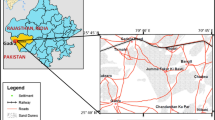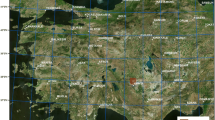Abstract
Use of high-resolution and historic CORONA satellite photographs for mapping and other purposes requires Ground Control Points (GCPs), as ephemeris data and image parameters are not available. However, the alterations in landscape in last 34 years (i.e., since the acquisition of these photographs) prevent identification and collection of large number of GCPs in the field. This paper presents a methodology for collection of GCPs for CORONA photographs. The advantages and limitations of the methodology are discussed. For a study site, situated in Siwaliks and Lower Himalayas, the GCPs were identified in CORONA photographs and their WGS84 coordinates were estimated through a process of datum transformation and georeferencing. Estimated GCP coordinates from the topo sheets and 2D and 3D views of photographs, helped in identifying the GCP locations in field, which were observed using DGPS. Investigations were carried out to relate Differential Global Positioning System (DGPS) accuracy with base line length and time of observation. Abase line of 350 km and half an hour observation were found appropriate to yield accuracy in GCP collection by DGPS method, which conforms to CORONA resolution of 3 m.
Similar content being viewed by others
References
Altmaier, A. and Kany, C. (2002). Digital surface model generation from CORONA satellite images.ISPRS J. of Photogrammetry and Remote Sensing,56(4): 221–235.
Dashora, A. (2005). An investigation on photogrammetric modelling of CORONA satellite images for mapping purposes. M. Tech. Dissertation, Dept. of Civil Engineering, Indian Institute of Technology Kanpur, Kanpur (India).
Leachtenaver, J., Daniel, K. and Vogl, T. (1998). Digitizing satellite imagery: Quality and cost considerations.Photogrammetric Engineering & Remote Sensing,64(1): 29–34.
Leica (2000). Users Manual: General Guide to rapid and rapid static survey, GPS system 500. ver. 2, pp 1–41.
Lillesand, T.M., Kiefer, R.W. and Chipman, J.W. (2004). Remote Sensing and Image Interpretation. 5th ed., John Wiley & Sons, New York, USA, 167p.
McDonald, R.A. (1995). CORONA: Success for Space Reconnaissance, A Look into the Cold War, and a Revolution for Intelligence,Photogrammetric Engineering and Remote Sensing,61(6): 689–720.
Shin, S.W. (2003). Rigorous Model of Panoramic Cameras, Ph.D. Dissertation, Dept. of Civil and Environmental Engineering and Geodetic Science, Ohio State University, USA. http://www.ohiolink.edu/etd/sendpdf.cgi?osu 1048869881 (accessed 16 August, 2004).
Sohn, H.G., Kim, G.H. and Yom, J.H. (2004). Mathematical Modeling of Historical Reconnaissance CORONA KH-4B Imagery.The Photogrammetric Record,19(105): 51–66.
Sreenivas, B. (2003). A comparative study of GPS and Total Station surveys for control establishment, M.Tech. Dissertation, Dept. of Civil Engineering, Indian Institute of Technology Kanpur, Kanpur (India).
Author information
Authors and Affiliations
Corresponding author
About this article
Cite this article
Dashora, A., Sreenivas, B., Lohani, B. et al. GCP collection for corona satellite photographs: Issues and methodology. J Indian Soc Remote Sens 34, 153–160 (2006). https://doi.org/10.1007/BF02991820
Received:
Revised:
Issue Date:
DOI: https://doi.org/10.1007/BF02991820




